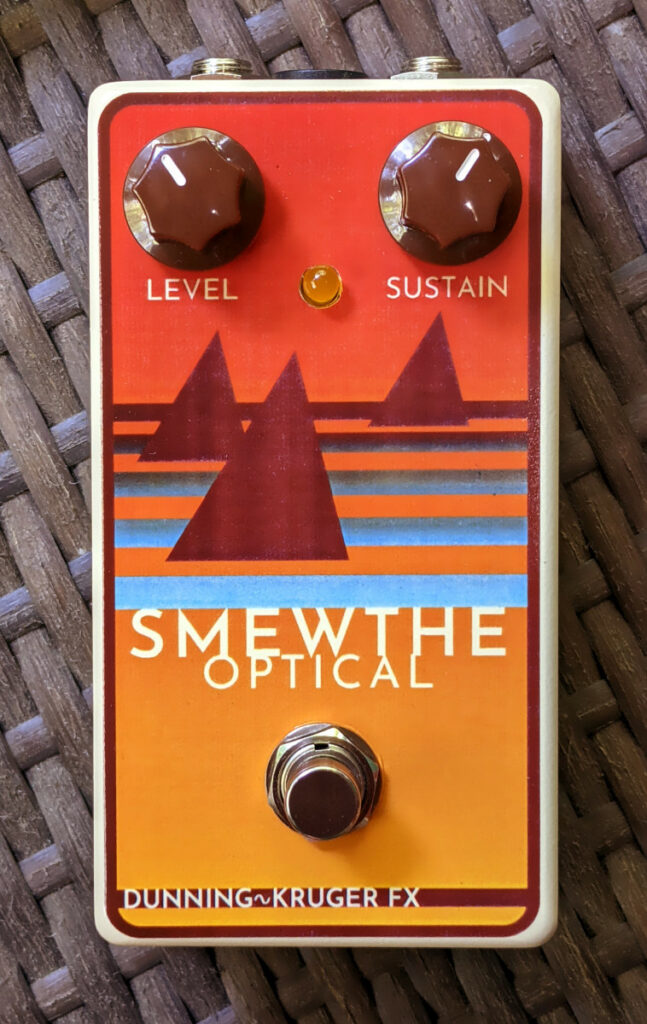

Still Smooth
Is it lame to reuse a pedal enclosure design? Well, the best thing about making your own pedals is that you don’t have to answer to anyone except for your own pernicious self-doubt.
Yes, this is basically the same case design as Smewthe, the other Dunning∿Kruger compressor, but it’s entirely different between the jacks. I just like the image.
The “brown sailboats on an orange/yellow gradient” motif came out of an old collaboration. Some time in 2011, a friend of mine saw a logo on a waterfront condo in Toronto. He asked if I could tweak it to make it more “yacht rock” and get it into an image format that he could have printed onto the head of his kick drum. We went through several iterations and arrived at basically what’s on the Smewthe pedals. Although it was entirely his vision, I don’t think it ever made it on to a kick drum…but I’ve used it for several things over the past decade. It has a lot of overlap with other interests of mine, like sailboats and really smooth music, so I’ve probably had more opportunities. It would still look rad on a kick drum though.
It’s Optical
There needs to be something in any compressor that can electronically adjust the gain reduction based on the input. There are several common approaches to this, using various types of transistors, op-amps, vacuum tubes, digital stuff, etc., but one particularly cool way is to use light. The “Optical” in Smewthe Optical refers to the fact that there’s an LED in there in there that gets brighter or dimmer based on the input signal, and an LDR (light dependent resistor, aka photocell) that changes its resistance based on how much light receives and controls the level. While light is fairly fast, the LED can’t change brightness instantaneously and the LDR is relatively slow at reacting to it. That lag smooths things out in a complex, nonlinear way that happens to sound pretty good.
The LED/LDR combo is sometimes packaged up into a single unit called a vactrol or optocoupler that has both components inside a little box to keep stray light from getting in. One of my main reasons for wanting to try this pedal was that I had to find a vactrol for the Toynbee fuzz, and wound up buying extras. Smewthe Optical is built on a BYOC Optical Compressor board (but not from the full kit).
Vital Stats
Sound
I am not a compressor connoisseur, and much of my impetus for building these was to learn more about them. Unlike gain or modulation effects, compression isn’t always an obvious effect. It’s often subtle, and sometimes a compressor’s value is more about how it makes the instrument “feel” to the player or how it makes a part sit in a mix rather than how it sounds in the abstract. That said, compression can impart a distinctly “compressed” sound, and this pedal will do more of that than the original Smewthe at its most extreme settings…although at those settings the attack and decay are also blatant, and the optical lag becomes apparent. I can’t think of an immediate use for that sort of thing (but I may someday). At more moderate settings, it’s relatively similar to other compressors that I’ve used, perhaps a little less noisy and a little less picky about letting transients get through. I really need to spend more time with it. Nevertheless, I have thrown together a sloppy but brief sound sample, mostly because I liked what it did to a high-strung guitar to make it sound more like a harpsichord.
The ridiculously bright-sounding thing is a high-strung (aka Nashville Tuned) Squire Mustang. There’s a Coronacaster in there too. The lead-ish noodling is the Emomaster and the bass is my P-bass. All of these were played through the Smewthe Optical into a Fender Deluxe Reverb and recorded and mixed without much additional compression (just a limiter on the master track.)





